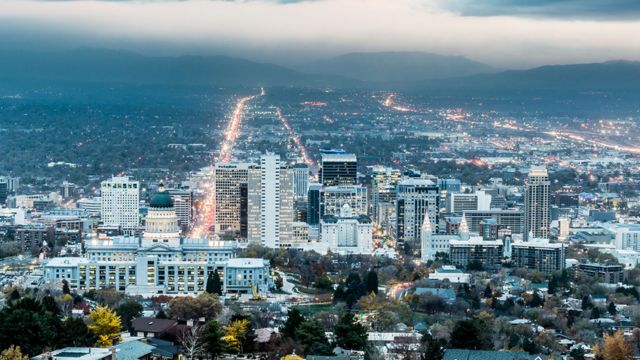WFCN –
In Liberty County, Texas, where non-white population increased by more than 7 percentage points since 2020 to almost 52% of the total, students celebrate graduation in May at Cleveland High School. This county is one of the most rapidly changing in the nation.
There have been five counties in Texas that have become majority non-white since 2020. Vanesa Brashier/Bluebonnetnews.com
A recent Stateline report highlights the ways in which cities and suburban counties are being impacted by the growth of Asian, Black, and Hispanic communities.
This transformation is particularly noticeable in red states like Texas, Florida, and Indiana. Pennsylvania, Nevada, and Georgia—all states that could sway the election—were also among the states that changed the most quickly.
According to the analysis of U.S. Census Bureau projections issued in June, the non-white population share increased in 47 states from mid-2020 to mid-2023.
The highest shift was in Nevada, where the non-white population, primarily Hispanic, increased by 2.3 percentage points to 54.3% of the total. As the number of Black Georgians continued to rise, the state’s population shifted to 49.9%, making it nearly majority non-white. This shift coincided with a Democratic sweep in the state’s presidential and senate races in 2020.

There is a great deal of demographic diversity in these rapidly expanding metro areas, which rank among the largest in the nation.
Lloyd Potter, the Texas State Demographer
In both rural and urban areas, as well as in blue and red counties, the Stateline analysis found that hispanic increase was the most prominent determinant. The Hispanic population is seeing growth due to both immigration and rising birth rates, according to the Census Bureau.
The percentage of white residents has increased in just three states since 2020: Tennessee, South Carolina, and Montana. The District of Columbia is also not among these states.
SEE MORE –
Moped and E-Bike Riders Must Comply with New State Safety Regulations
Although the political loyalties of Hispanics and Blacks have changed recently, the locations of these population increases could influence the results of the 2024 presidential race as well as local and state elections. Even while they used to be some of the Democrats’ most ardent backers, black voters’ enthusiasm has waned recently. Additionally, the Republican Party is seeing a rise in support from Hispanic voters.
Migration of Asians and Blacks to urban centers and suburbs in red states, which are rich in jobs, was a major factor in many of the most significant shifts. Almost every national indicator shows that the economy is booming, and one big reason why is the abundance of jobs outside of big cities.
As of mid-2023, new non-white majorities were formed in some places, including Marion County, Indiana (home of Indianapolis), and Kaufman County, Texas (a Dallas suburb), both of which saw increases in the Black population. Hispanics increased by 3 percentage points to 28% of Kaufman County’s population, while Blacks increased by 6 percentage points to 23%. In 2020, Kaufman County chose its first district judge who was African American.
“We do have jobs here, and all those counties are growing dramatically,” remarked Lloyd Potter, the state demographer of Texas. Dallas, he added, as well as neighboring states like California and New York, are seeing a mass exodus of Asian, Black, and Hispanic citizens to the suburbs. The white population in the area is getting older and shrinking as a result of fewer births and more deaths.
“According to the new census data, there is a remarkable diversity in the population in these large and rapidly expanding urban centers across the nation. According to Potter, “it appears to have accelerated over the last five years or so,” albeit it has been happening for a while.
Changing politics, new groceries
The Black community in Kaufman County is on the rise, but it is still a small minority in a county that went Republican in both the 2020 and 2022 presidential elections. Hearings were held by the county commission in 2021 regarding the relocation of a monument honoring the Confederacy from the entryway of the county courthouse; however, no action was taken at that time.
SEE MORE –
High Price Home, Left! 3 States Predicted to Have the Highest Home Price Growth in 5 Years
Here, it’s crimson. It’s really red,” remarked James Henderson, a lifelong county resident who advocated for the statue’s relocation. Forney and other communities in Kaufman County are becoming popular with African Americans like him who are looking for remote employment opportunities with corporations in Dallas, he said. The number of African immigrants is also on the rise, he added.
It remains to be seen whether a more diverse political landscape will result from more racial inclusion. The influx of Black people to the Atlanta area in Georgia impacted the 2018 and 2020 elections, although Republicans still hold a tight grip on both the state governments in Georgia and Texas.
According to William Frey, a demographer from the left-leaning Brookings Institution think tank, the diversity of the younger generation is on the rise. The majority of the elderly population is white, he added, and this demographic is on the rise due to the aging baby boomer generation.
Since 2020, two large counties in Florida—Duval County, home of Jacksonville—and Collin County, another Dallas suburb, have become majority non-white due to Asian and Hispanic population increases, respectively.
According to Farhad Wadia, president of the FunAsia branded radio stations in the area, a large number of the new inhabitants of Collin County are tech professionals from southern India who speak Telugu. They have discovered a way to make a living by working remotely for Dallas enterprises. Little things are changing around here because of them, he said.
During their elaborate Hindu housewarming rituals, newly transplanted people often boil milk until it overflows as a symbol of prosperity. Shops provide curries made with tamarind and sun-dried peppers to satisfy their acidic palates.
Wadia warned that a visit to this Costco might lead customers to believe they were in South India. “Many of them are transplants from California, where they could make a million bucks off of a 1,000-square-foot home and still not meet their needs here.”
Expanding rural population diversity
Five counties in Texas were among the sixteen that experienced a majority non-white population between 2020 and 2023. In 2020, Republicans managed to secure the majority of votes cast in the sixteen counties.
They comprised two counties in California (Napa and Yuba), one in New Mexico (rural Quay and Roosevelt), one in Alabama (rural Conecuh), one in Kansas (rural Stanton), one in Mississippi (Lowndes County, along the Alabama border), one in New Jersey (suburban Somerset County), and one in South Carolina (Florence County, near Myrtle Beach). Every state had four counties represented.
Henry County, a suburb of Atlanta in Georgia, had the biggest change of any county in the state outside of Texas, as the non-white population increased by 7 points to 69% due to the growth of the Black population. Retired NBA player Shaquille O’Neal, who purchased a property in the county in 2016, is involved with the local sheriff’s office in community relations and recently organized a summer sports camp for youngsters. In 2020, the county was already majority-Black.
There has been a precipitous fall in the quantity of available jobs across the board.
The percentage of non-whites in the presidential swing states of Wisconsin, Pennsylvania, and Michigan was further boosted by the expansion of the Hispanic population.
Schools in Liberty County, Texas, are overflowing with new Hispanic pupils, according to Stephen McCanless, superintendent of the Cleveland Independent School District. This is due in large part to the county’s rapidly growing Hispanic population, which has contributed to a new non-white majority of 52%, an increase of 7 percentage points since 2020.
According to him, the district’s enrollment increased from 10,000 to 12,000 children last school year and could reach 14,000 next year, with around 88% of those pupils being Hispanic.
Although bond measures to construct additional schools were rejected, the district has spent over $17 million on temporary classrooms since growth began in 2015, with $2 million going into this year alone.
We had to make some difficult choices. According to McCanless, in order to begin the upcoming school year without depleting the financial balance excessively, $7 million was removed from the budget.
